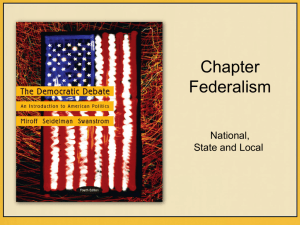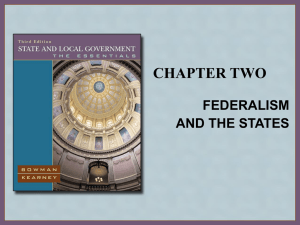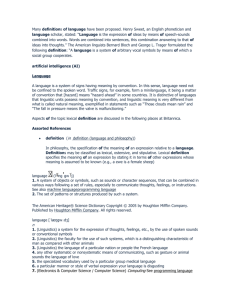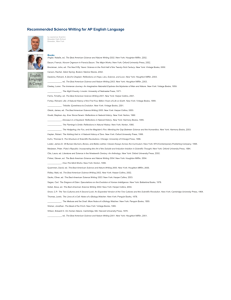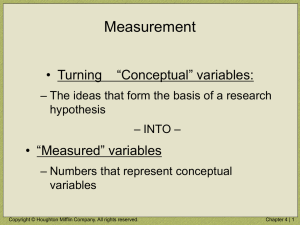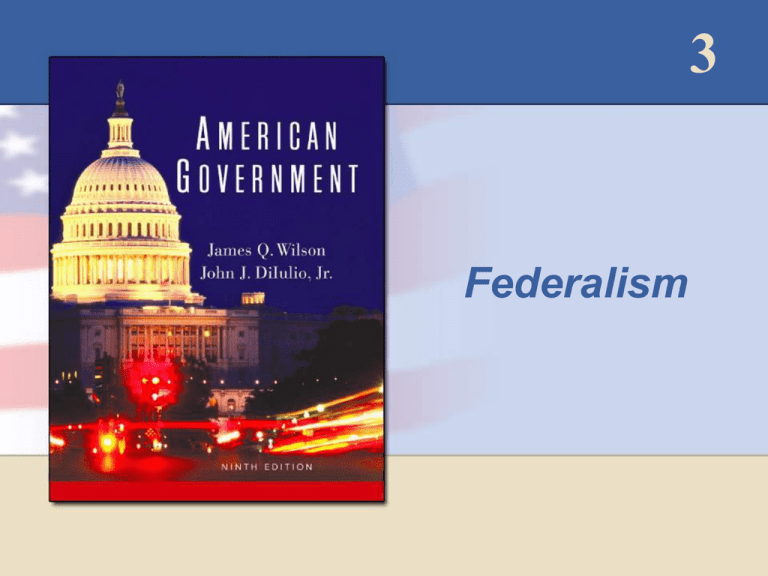
3
Federalism
Figure 3.1: Lines of Power in Three Systems of
Government
Copyright © Houghton Mifflin Company. All rights reserved.
3-2
Figure 3.1: Lines of Power in Three Systems of
Government (cont’d)
Copyright © Houghton Mifflin Company. All rights reserved.
3-3
Figure 3.1: Lines of Power in Three Systems of
Government (cont’d)
Copyright © Houghton Mifflin Company. All rights reserved.
3-4
Historical Background, critiques and praises
Unitary Examples: France, Britain, Italy, Sweden
Federal Examples: US, Canada, India, Germany, Switzerland, Australia
Confederal Examples: A of C, CSA, UN (“Stop, or I’ll Say Stop Again!”- R. W.)
Negative Views: federalism blocks progress and protects powerful local interest
a) Laski: the states are “parasitic and poisonous”
b) Riker: federalism facilitated the perpetuation of racism
Positive View:
a) Elazar: federalism contributes to governmental strength, political
flexibility, and fosters individual liberty
Federalism has good and bad effects
a) Different political groups with different political purposes come to
power in different places
b) Federalist #10: small political units are more likely to be dominated
by single political faction
c) Increased political activity, facilitates pol. mobilization, < local cost
Grodzins: What is his perspective and views? What marbles the cake (prime
factor)?
Copyright © Houghton Mifflin Company. All rights reserved.
3-5
Federalism and Constitutional Law
Two sides historically: Hamilton (supremacy) and Jefferson (states’ rights)
10th amendment supports states, Elastic clause supports nat’l supremacy
Key case: McCulloch v. Maryland (1819), with Marshall as arbiter
1865: Court said fed gov’t could regulate inter but not intrastate commerce
1937: No longer able to distinguish between, “switch in time that saves nine:”
Congress can regulate both
Court struggles based on desires to support laissez-faire theory; true l-f?
-Based on natural law conceptions of property rights
-Corporations mistakenly perceived as individuals under the law
Current conception: a return to “dual federalism:” Scalia in Printz. How?
-See also: US v. Lopez (1995), also about guns
State sovereignty also recently protected through the 11th Amendment.
States still clearly politically inferior
Copyright © Houghton Mifflin Company. All rights reserved.
3-6
The Politics of Federalism
Power has shifted to federal government dramatically, 1937-present
Concern for local control over-exaggerated, but prevalent
1960s grant-in-aid programs shifted symmetry of federal system to nat’l control
State/local gov’ts became increasingly dependent on federal aid
Representatives of these groups set up intergovernmental lobbying offices: DC
Rivalry between states intensified: distributionally-based block grants the norm
Block grants led to more federal regulation, not less. Dependent state agencies
formed, needing funding to survive. Fought for turf, and decreased the
overall amount of block grant funds available as they “tied funding up.”
Ideological dimension soon emerged:
-Liberals, Democrats, minorities liked federal influence on biased local officials
-Conservatives, Republicans, business leaders liked local control to avoid
inflexibility/perpetuate freedom of choice
-1980s/1990s stalemates during eras of divided government
-Change being forced by States tired of federal meddling, and level of
professionalism has improved on local level, leading to positive experimentation
-Example: Welfare reform pursued successfully on state/local level. Results?
Copyright © Houghton Mifflin Company. All rights reserved.
3-7
Figure 3.2: The
Changing
Purpose of
Federal Grants
to State and
Local
Governments
Source: Budget of the U.S. Government,
Fiscal year 2001, table 12.2.
Copyright © Houghton Mifflin Company. All rights reserved.
3-8
Figure 3.3: Federal Grants to State and Local
Governments, 1983-2003
Source: Budget of the U.S. Government, Fiscal Year 2002, Historical Tables, Composition of Outlays, table 6.1.
Copyright © Houghton Mifflin Company. All rights reserved.
3-9
Figure 3.4: Dealing with Deficit
Source: From "Dealing with Deficit, "Council of State Governments, National Conference of State Legislatures, as reported in
Governing, May 2002, p. 22. Reprinted with permission.
Copyright © Houghton Mifflin Company. All rights reserved.
3 - 10
Figure 3.5: The Politics of Devolution
Source: Survey by the Los Angeles Times, January 19-22, 1995, as published in The Public Perspective (Storrs: Roper Center for
Public Opinion Research, University of Connecticut), April/May 1995):28.Copyright The Public Perspective. Reprinted by permission
Copyright © Houghton Mifflin Company. All rights reserved.
3 - 11




